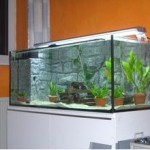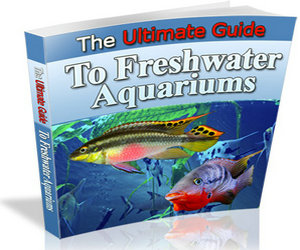
There are two basic cases where the maximum fish population in an aquarium must be considered. The previous tip, How Many Fish in a New Set-Up – Set-Up Tip 6, discussed the first rule of thumb for adding the first fish to a newly established system. These are fish tanks that have not had an opportunity to establish a viable biological filter yet. They are, for all practical purposes, aquariums that have been started from a sterile environment.
That rule stated “One inch of fish per gallon, measuring the fish from head to end of tail”. Following that rule, in a strict fashion, will help prevent the toxicity of both ammonia and nitrite from ever becoming lethal. Of course, the correct fish population needs to be introduced right from the start. Delicate species should never be used. Only hardy species should ever be considered in the beginning aquarium.
Once the bacterial filter has become established strongly enough to eliminate all the ammonia and nitrite as soon as it is produced, the Nitrogen Cycle has become well established. At this point, the mature system can tolerate a gradual increase in the total bio-load it is able to support. The two bacteria strains required, nitrosomonas and nitrobacter should have reached a balance between ammonia and nitrite production and immediate reduction. Once these populations have matured, the maximum fish population that a standard aquarium, with suitable and strong filtration can safely accommodate is about:
Two inches per gallon.
But in this case, unlike the original rule where all occupants were used in the calculation, we tend to ignore any bottom fish. We also do not count the tail length of the fish housed in the aquarium either.
So in this scenario, the fish capacity has actually much more than doubled.
It is very important to clearly understand, this is not a license to suddenly increase the population to maximum once the ammonia and nitrite levels read zero. Rather, this is the upper limit of the biological load that can be safely handled by the Eco-system for the long-term health of the entire system. This upper threshold should only be gradually reached over time. Remember that the beneficial bacterial filter is completely dependent on the amount of ammonia that is produced. The filter must be given time to adjust as the fish population is built up. Sudden increase with a lot of fish all at once will increase the ammonia load dramatically in a very short period of time.
Any time the fish population is supplemented, this new bioload level automatically increases the ammonia production. The bacterial population will readily adapt and increase to deal with the new levels, but it takes time. When there is a sudden increase in ammonia and other waste production, it may take a few days to catch up. During this time there can be a spike first in the concentration of ammonia and then shortly after: nitrite. This can create sudden toxic level spikes that seriously stress the fish and other aquatic inhabitants.
It is pretty obvious that it is much better to add fish gradually, over time. Let the biological filter adapt with as little disruption as possible. The idea of this article is to provide an upper limit in this calculation for the number of fish possible for any given capacity of water. Your goal should not be to reach it as rapidly as possible. Attempt to maintain the community in a healthy balance and only bring the numbers up in a gradual and controlled manner.
















